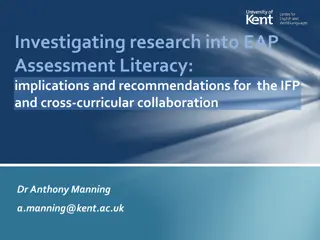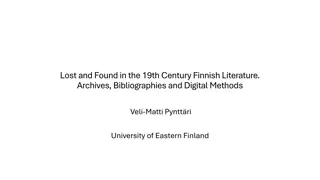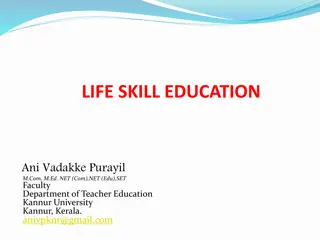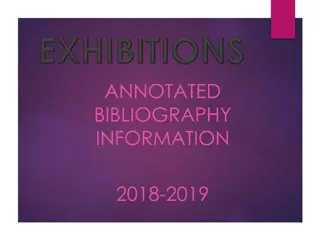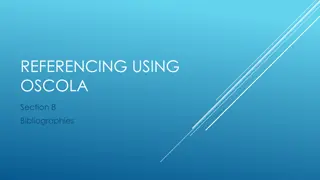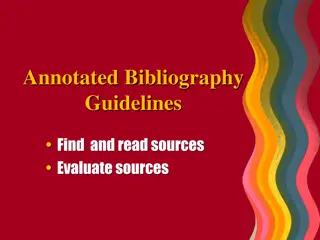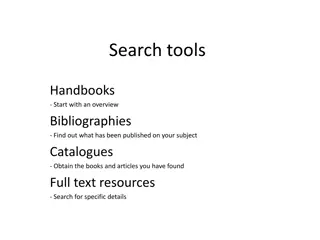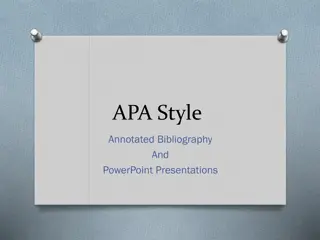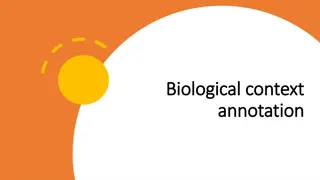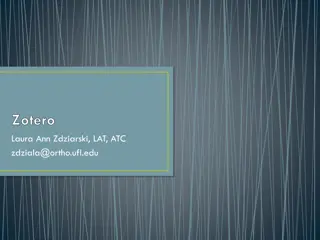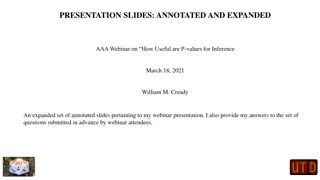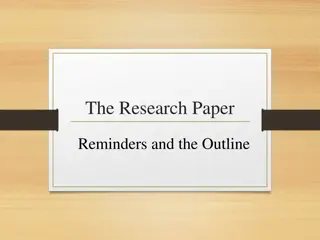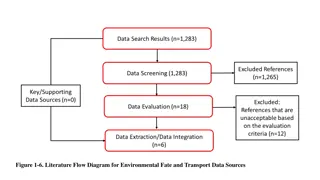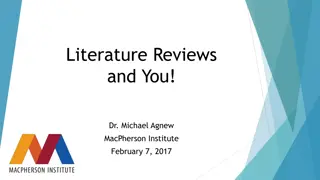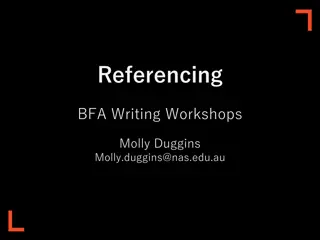Research Skills and Annotated Bibliographies Overview
Delve into the world of research skills and annotated bibliographies with a comprehensive view on literature review formats, search strategies, tools, paraphrasing, citation management, IMRaD format, integrating feedbacks of terrestrial ecosystems to climate change, and finding a balance in search sensitivity and specificity. Explore processes for identifying main ideas, narrowing or broadening topics, and engaging in activities related to search terms and adapting topics.
Download Presentation

Please find below an Image/Link to download the presentation.
The content on the website is provided AS IS for your information and personal use only. It may not be sold, licensed, or shared on other websites without obtaining consent from the author.If you encounter any issues during the download, it is possible that the publisher has removed the file from their server.
You are allowed to download the files provided on this website for personal or commercial use, subject to the condition that they are used lawfully. All files are the property of their respective owners.
The content on the website is provided AS IS for your information and personal use only. It may not be sold, licensed, or shared on other websites without obtaining consent from the author.
E N D
Presentation Transcript
Research Skills Annotated Bibliographies
Outline Review of literature formats Strategies for searching Search tools Annotated bibliographies Paraphrasing Citation management
Outline Example Feedbacks of Terrestrial Ecosystems to Climate Change | ABSTRACT | KEY WORDS | INTRODUCTION | GREENHOUSE GAS FEEDBACKS | OTHER CLIMATE FEEDBACKS | INTERACTING CLIMATE AND HUMAN FACTORS | INTEGRATION | SUMMARY POINTS | FUTURE ISSUES | DISCLOSURE STATEMENT | ACKNOWLEDGMENTS | LITERATURE CITED https://doi.org/10.1146/annurev.energy.32.053006.141119
Search A balancing act | Sensitivity Capture most relevant results Capture more irrelevant results Spend more time filtering/screening | Specificity (Precision) Capture some relevant results Capture fewer irrelevant results Risk missing relevant results
Process Identify main ideas Think of search terms for the main ideas Combine Search Evaluate results Repeat
Main ideas What is your population/organism of interest? What is your environment/location of interest? What phenomenon/issue is of interest? What adaptation/mechanism is of interest? What outcome(s) is of interest?
Activity: Search Terms How do greenhouse gases affect the arctic? Mentimeter.com
Narrowing/broadening your topic Broadening | Organism Oncorhynchus > Salmonidae | Location Great Lakes > lakes in general Narrowing | Aspect Phenomenon/Issue- that is happening to an ecosystem Adaptation > specific function/mechanism Outcome - variable of interest
Activity: Narrowing/Broadening How do greenhouse gases affect the arctic? Mentimeter.com
Techniques for Searching Boolean operators | AND (for combining different concepts, finds fewer results) | OR (for combining related terms, finds more results) | NOT (for eliminating irrelevant results, finds less results) Phrase searching | Quotations carbon sequestration Truncation | Asterix oxygen* Brackets | Isolate your main ideas, gather together your search terms (lake OR river) AND (salmon OR Salmonidae)
Strategies for Searching Main ideas Search terms Discover new terms Filters | Date | Subject categories | Document types | Search within Author keywords Controlled vocabulary Related/Similar articles Author search Citation tracking Review articles
Search Tools Web of Science OMNI Google Scholar
Annotated bibliography Definition | An annotated bibliography is a list of citations to books, articles, and documents. Each citation is followed by a brief descriptive and evaluative paragraph, the annotation. The purpose of the annotation is to inform the reader of the relevance, accuracy, and quality of the sources cited. https://guides.library.cornell.edu/annotatedbibliography
Annotation vs Abstract Abstract | Abstracts are purely descriptive summaries usually found at the beginning of scholarly journal articles. Annotation | Annotations are descriptive and critical; they describe the article/source and the author s assessment of the article/source
Components Author Name/Credentials Rationale Hypothesis Methods Results Conclusion Evaluation Significance Relevance
Components Author Name/Credentials Rationale Hypothesis Methods Results Conclusion Evaluation Significance Relevance Description Critique
Example Citation | Lozier, J., Aniello, P., & Hickerson, M. (2009). Predicting the Distribution of Sasquatch in Western North America: Anything Goes with Ecological Niche Modelling. Journal of Biogeography,36(9), 1623-1627. Retrieved from http://www.jstor.org/stable/40305930 Annotation | This paper critiques the use of Ecological Niche Models (ENM) and species distribution by performing a tongue-in-cheek examination of the distribution of the fictional Sasquatch, based on reports from an online Bigfoot archive. Lozier's paper powerfully demonstrates the issues faced by ENM, when reports come from non-specialists, and highlights key problems with sourcing data from unmediated online environments. The author neglects to compare the reliability of the many wildlife databases with the single Bigfoot database, as well as other key issues; however in closing, the paper briefly mentions that many issues lie outside the scope of the short article. Lozier's paper advises professionals in fields using ENM to carefully assess the source of the data on which the model is based and concludes that the distribution of rare species in particular is often over-reported to misidentification. https://www.lib.sfu.ca/help/cite-write/citation-style-guides/annotated-bibliography
Example Citation | Lozier, J., Aniello, P., & Hickerson, M. (2009). Predicting the Distribution of Sasquatch in Western North America: Anything Goes with Ecological Niche Modelling. Journal of Biogeography,36(9), 1623-1627. Retrieved from http://www.jstor.org/stable/40305930 Annotation | This paper critiques the use of Ecological Niche Models (ENM) and species distribution by performing a tongue-in-cheek examination of the distribution of the fictional Sasquatch, based on reports from an online Bigfoot archive. Lozier's paper powerfully demonstrates the issues faced by ENM, when reports come from non-specialists, and highlights key problems with sourcing data from unmediated online environments. The author neglects to compare the reliability of the many wildlife databases with the single Bigfoot database, as well as other key issues; however in closing, the paper briefly mentions that many issues lie outside the scope of the short article. Lozier's paper advises professionals in fields using ENM to carefully assess the source of the data on which the model is based and concludes that the distribution of rare species in particular is often over-reported to misidentification. https://www.lib.sfu.ca/help/cite-write/citation-style-guides/annotated-bibliography
Annotated Bib vs Lit Review A literature review is not the same as an annotated bibliography. The latter describes and evaluates each text in turn. A literature review synthesizes the contributions of the different authors and comments on their strength and relative contribution. https://services.unimelb.edu.au/__data/assets/pdf_file/0009/821727/Reviewing_the_Literature_150613.pdf
Summary vs Synthesis Summary A summary is a brief statement of a source(s) Synthesis An integrated essay based on multiple sources In order to synthesize several sources you need to understand each source individually, summarizing can help with this
Synthesis Synthesis = literature review Your data/evidence is other people s papers Your contribution is how you organize and make connections between all of these papers It is easy to find sources that confirm your ideas (confirmation bias), try to find diverse sources
Synthesis Identify Common Themes Contrast and Compare Make connections Identify Gaps
Identify Common Themes Hypotheses Populations Theories Methods Locations Outcomes
Contrast and Compare Do different studies agree or disagree? Do they agree on some things but disagree on others? Example Although most scientists attribute _____ to _____, X s result _____ leads to the possibility that _____. Graff, G. & Birkenstein, C. (2014). They say/I say: The moves that matter in academic writing. New York: W.W. Norton & Company.
Make connections What is the relationship between studies? Examples Because ______ does not account for _____, X instead used _____. By demonstrating _____, X s work extends the finding of Y. Graff, G. & Birkenstein, C. (2014). They say/I say: The moves that matter in academic writing. New York: W.W. Norton & Company.
Identify Gaps What is missing? What can be studied next? Example Now that ______ has been established, scientists will likely turn their attention toward ______. Graff, G. & Birkenstein, C. (2014). They say/I say: The moves that matter in academic writing. New York: W.W. Norton & Company.
Paraphrasing Definition | presenting the ideas and information you have read in your own words | not simply taking what someone has written and changing a few words to make it your own. It is about translating another person's ideas into your own words and in reduced form | change the words and sentence structure a lot so they are no longer similar to the original https://lo.unisa.edu.au/course/view.php?id=3839§ionid=555771
Paraphrasing How to paraphrase https://lo.unisa.edu.au/course/view.php?id=3839§ionid=555771
Paraphrasing Techniques 1. Start your first sentence at a different point from that of the original source 2. Use synonyms (words that mean the same thing) 3. Change the form of words (verbs to nouns) 1. analyse > the analysis 4. Change the sentence structure (eg: from active to passive voice) https://lo.unisa.edu.au/course/view.php?id=3839§ionid=555771
Paraphasing - Activity Ecosystems are a net sink for carbon, removing CO2from the atmosphere, when plant photosynthesis exceeds the sum of respiration and combustion, and they are a source when respiration and combustion exceed photosynthesis. The sum of photosynthesis and respiration (or net ecosystem production) provides one window on ecosystem influences on atmospheric CO2, and the sum of photosynthesis, respiration, combustion, harvesting, and other forms of offsite transport (net biome production) provides another (21). https://doi.org/10.1146/annurev.energy.32.053006.141119
Paraphasing - Activity https://bit.ly/BIOL3602
Citation Management Zotero


